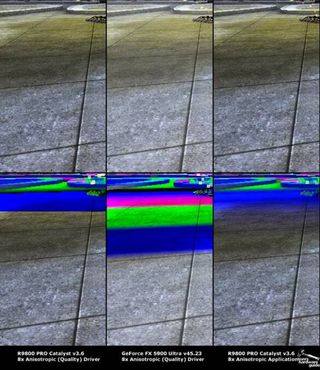NVIDIA Detonator FX 45.23
Drivers And Applications, Continued
Finally, here is a comparison between ATI's Radeon 9800 PRO and NVIDIA's FX 5900 Ultra filtering:

The image shown here is compressed and therefore somewhat misleading. Click on the image in order to get an uncompressed BMP.
And another image:

The image shown here is compressed and therefore somewhat misleading. Click on the image in order to get an uncompressed BMP.
ATI's optimization proves itself to be considerably more aggressive than NVIDIA's. The transitions suggest a purely bilinear anisotropic filtering. ATI, however, uses a higher filter level than NVIDIA (the mipmap surfaces fall further behind). It's a different picture when the application takes over the filtering controls. In this case, the driver's optimized filtering is deactivated and full trilinear anisotropic filtering then comes into use.
Whether or not ATI really intended this effect is a matter of debate, since the option of "real filtering" cannot be found in the driver menu. The driver help file doesn't offer any information about this, either. But as long as the application lets you invoke anisotropic filtering from the driver, then at least with ATI cards, you have the possibility of getting real trilinear filtering.
The differences in image brightness in the screenshots from the two cards are instigated by the gamma function of the Hypersnap screen capture tool and should be ignored when viewing.
Stay on the Cutting Edge
Join the experts who read Tom's Hardware for the inside track on enthusiast PC tech news — and have for over 25 years. We'll send breaking news and in-depth reviews of CPUs, GPUs, AI, maker hardware and more straight to your inbox.
Current page: Drivers And Applications, Continued
Prev Page Drivers And Applications, Continued Next Page Image Quality: Quake 3 Team ArenaMost Popular

